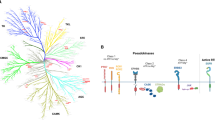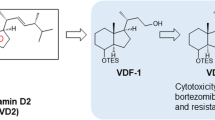Abstract
Resistance to proteasome inhibitors (PIs) has emerged as an important clinical issue. We investigated the mechanisms underlying multiple myeloma (MM) cell resistance to PIs. To mimic their pharmacokinetic/pharmacodynamic (PK/PD) profiles, MM cells were treated with bortezomib and carfilzomib for 1 h at concentrations up to 400 and 1,000 nM, respectively. Susceptibility to these PIs markedly varied among MM cell lines. Pulsatile treatments with PIs suppressed translation, as demonstrated by incorporation of puromycin at 24 h in PI-susceptible MM.1S cells, but not PI-resistant KMS-11 cells. Inhibition of β5 subunit activity decreased at 24 h in KMS-11 cells, even with the irreversible PI carfilzomib, but not under suppression of protein synthesis with cycloheximide. Furthermore, the proteasome-degradable pro-survival factors PIM2 and NRF2 acutely accumulated in MM cells subjected to pulsatile PI treatments. Accumulated NRF2 was trans-localized into the nucleus to induce the expression of its target gene, HMOX1, in MM cells. PIM and Akt inhibition restored the anti-MM effects of PIs, even against PI-resistant KMS-11 cells. Collectively, these results suggest that increased synthesis of β5 proteasome subunit and acute accumulation of PIM2 and NRF2 reduce the anti-MM effects of PIs.






Similar content being viewed by others
Data availability
Data are available upon reasonable request.
References
Asano J, Nakano A, Oda A, Amou H, Hiasa M, Takeuchi K, et al. The serine/threonine kinase Pim-2 is a novel anti-apoptotic mediator in myeloma cells. Leukemia. 2011;25(7):1182–8. https://doi.org/10.1038/leu.2011.60.
Hiasa M, Teramachi J, Oda A, Amachi R, Harada T, Nakamura S, et al. Pim-2 kinase is an important target of treatment for tumor progression and bone loss in myeloma. Leukemia. 2015;29(1):207–17. https://doi.org/10.1038/leu.2014.147.
Adam K, Lambert M, Lestang E, Champenois G, Dusanter-Fourt I, Tamburini J, et al. Control of Pim2 kinase stability and expression in transformed human haematopoietic cells. 2015. Biosci Rep. https://doi.org/10.1042/bsr20150217.
Fujii S, Nakamura S, Oda A, Miki H, Tenshin H, Teramachi J, et al. Unique anti-myeloma activity by thiazolidine-2,4-dione compounds with Pim inhibiting activity. Br J Haematol. 2018;180(2):246–58. https://doi.org/10.1111/bjh.15033.
Itoh K, Wakabayashi N, Katoh Y, Ishii T, Igarashi K, Engel JD, et al. Keap1 represses nuclear activation of antioxidant responsive elements by Nrf2 through binding to the amino-terminal Neh2 domain. Genes Dev. 1999;13(1):76–86. https://doi.org/10.1101/gad.13.1.76.
Kobayashi A, Kang MI, Watai Y, Tong KI, Shibata T, Uchida K, et al. Oxidative and electrophilic stresses activate Nrf2 through inhibition of ubiquitination activity of Keap1. Mol Cell Biol. 2006;26(1):221–9. https://doi.org/10.1128/mcb.26.1.221-229.2006.
Rada P, Rojo AI, Chowdhry S, McMahon M, Hayes JD, Cuadrado A. SCF/{beta}-TrCP promotes glycogen synthase kinase 3-dependent degradation of the Nrf2 transcription factor in a Keap1-independent manner. Mol Cell Biol. 2011;31(6):1121–33. https://doi.org/10.1128/mcb.01204-10.
Rada P, Rojo AI, Evrard-Todeschi N, Innamorato NG, Cotte A, Jaworski T, et al. Structural and functional characterization of Nrf2 degradation by the glycogen synthase kinase 3/β-TrCP axis. Mol Cell Biol. 2012;32(17):3486–99. https://doi.org/10.1128/mcb.00180-12.
Chowdhry S, Zhang Y, McMahon M, Sutherland C, Cuadrado A, Hayes JD. Nrf2 is controlled by two distinct β-TrCP recognition motifs in its Neh6 domain, one of which can be modulated by GSK-3 activity. Oncogene. 2013;32(32):3765–81. https://doi.org/10.1038/onc.2012.388.
Rojo AI, Medina-Campos ON, Rada P, Zúñiga-Toalá A, López-Gazcón A, Espada S, et al. Signaling pathways activated by the phytochemical nordihydroguaiaretic acid contribute to a Keap1-independent regulation of Nrf2 stability: Role of glycogen synthase kinase-3. Free Radical Biol Med. 2012;52(2):473–87. https://doi.org/10.1016/j.freeradbiomed.2011.11.003.
Yu C, Xiao JH. The Keap1-Nrf2 system: a mediator between oxidative stress and aging. Oxid Med Cell Longev. 2021;2021:6635460. https://doi.org/10.1155/2021/6635460.
Itoh K, Chiba T, Takahashi S, Ishii T, Igarashi K, Katoh Y, et al. An Nrf2/small Maf heterodimer mediates the induction of phase II detoxifying enzyme genes through antioxidant response elements. Biochem Biophys Res Commun. 1997;236(2):313–22. https://doi.org/10.1006/bbrc.1997.6943.
Abe M, Hiura K, Wilde J, Shioyasono A, Moriyama K, Hashimoto T, et al. Osteoclasts enhance myeloma cell growth and survival via cell-cell contact: a vicious cycle between bone destruction and myeloma expansion. Blood. 2004;104(8):2484–91. https://doi.org/10.1182/blood-2003-11-3839.
Bonet-Costa V, Sun PY, Davies KJA. Measuring redox effects on the activities of intracellular proteases such as the 20S Proteasome and the Immuno-Proteasome with fluorogenic peptides. Free Radical Biol Med. 2019;143:16–24. https://doi.org/10.1016/j.freeradbiomed.2019.07.020.
Harada T, Ohguchi H, Oda A, Nakao M, Teramachi J, Hiasa M, et al. Novel antimyeloma therapeutic option with inhibition of the HDAC1-IRF4 axis and PIM kinase. Blood Adv. 2023;7(6):1019–32. https://doi.org/10.1182/bloodadvances.2022007155.
Kuhn DJ, Chen Q, Voorhees PM, Strader JS, Shenk KD, Sun CM, et al. Potent activity of carfilzomib, a novel, irreversible inhibitor of the ubiquitin-proteasome pathway, against preclinical models of multiple myeloma. Blood. 2007;110(9):3281–90. https://doi.org/10.1182/blood-2007-01-065888.
Ameri K, Harris AL. Activating transcription factor 4. Int J Biochem Cell Biol. 2008;40(1):14–21. https://doi.org/10.1016/j.biocel.2007.01.020.
Goodman CA, Pierre P, Hornberger TA. Imaging of protein synthesis with puromycin. Proc Natl Acad Sci USA. 2012;109(17):E989. https://doi.org/10.1073/pnas.1202000109. (author reply E90)
Baird L, Yamamoto M. The molecular mechanisms regulating the KEAP1-NRF2 pathway. Mol Cell Biol. 2020. https://doi.org/10.1128/mcb.00099-20.
Bianchi G, Oliva L, Cascio P, Pengo N, Fontana F, Cerruti F, et al. The proteasome load versus capacity balance determines apoptotic sensitivity of multiple myeloma cells to proteasome inhibition. Blood. 2009;113(13):3040–9. https://doi.org/10.1182/blood-2008-08-172734.
Oerlemans R, Franke NE, Assaraf YG, Cloos J, van Zantwijk I, Berkers CR, et al. Molecular basis of bortezomib resistance: proteasome subunit beta5 (PSMB5) gene mutation and overexpression of PSMB5 protein. Blood. 2008;112(6):2489–99. https://doi.org/10.1182/blood-2007-08-104950.
Lü S, Wang J. The resistance mechanisms of proteasome inhibitor bortezomib. Biomark Res. 2013;1(1):13. https://doi.org/10.1186/2050-7771-1-13.
Shirazi F, Jones RJ, Singh RK, Zou J, Kuiatse I, Berkova Z, et al. Activating KRAS, NRAS, and BRAF mutants enhance proteasome capacity and reduce endoplasmic reticulum stress in multiple myeloma. Proc Natl Acad Sci USA. 2020;117(33):20004–14. https://doi.org/10.1073/pnas.2005052117.
Li B, Fu J, Chen P, Ge X, Li Y, Kuiatse I, et al. The Nuclear factor (Erythroid-derived 2)-like 2 and proteasome maturation protein axis mediate bortezomib resistance in multiple myeloma. J Biol Chem. 2015;290(50):29854–68. https://doi.org/10.1074/jbc.M115.664953.
Chen T, Ho M, Briere J, Moscvin M, Czarnecki PG, Anderson KC, et al. Multiple myeloma cells depend on the DDI2/NRF1-mediated proteasome stress response for survival. Blood Adv. 2022;6(2):429–40. https://doi.org/10.1182/bloodadvances.2020003820.
Op M, Ribeiro ST, Chavarria C, De Gassart A, Zaffalon L, Martinon F. The aspartyl protease DDI2 drives adaptation to proteasome inhibition in multiple myeloma. Cell Death Dis. 2022;13(5):475. https://doi.org/10.1038/s41419-022-04925-3.
Sun Y, Abdul Aziz A, Bowles K, Rushworth S. High NRF2 expression controls endoplasmic reticulum stress induced apoptosis in multiple myeloma. Cancer Lett. 2018;412:37–45. https://doi.org/10.1016/j.canlet.2017.10.005.
Adams J. The proteasome: a suitable antineoplastic target. Nat Rev Cancer. 2004;4(5):349–60. https://doi.org/10.1038/nrc1361.
Pérez-Galán P, Roué G, Villamor N, Montserrat E, Campo E, Colomer D. The proteasome inhibitor bortezomib induces apoptosis in mantle-cell lymphoma through generation of ROS and Noxa activation independent of p53 status. Blood. 2006;107(1):257–64. https://doi.org/10.1182/blood-2005-05-2091.
Fink EE, Mannava S, Bagati A, Bianchi-Smiraglia A, Nair JR, Moparthy K, et al. Mitochondrial thioredoxin reductase regulates major cytotoxicity pathways of proteasome inhibitors in multiple myeloma cells. Leukemia. 2016;30(1):104–11. https://doi.org/10.1038/leu.2015.190.
DeNicola GM, Karreth FA, Humpton TJ, Gopinathan A, Wei C, Frese K, et al. Oncogene-induced Nrf2 transcription promotes ROS detoxification and tumorigenesis. Nature. 2011;475(7354):106–9. https://doi.org/10.1038/nature10189.
Satoh H, Moriguchi T, Takai J, Ebina M, Yamamoto M. Nrf2 prevents initiation but accelerates progression through the Kras signaling pathway during lung carcinogenesis. Cancer Res. 2013;73(13):4158–68. https://doi.org/10.1158/0008-5472.Can-12-4499.
Tao S, Liu P, Luo G, Rojo de la Vega M, Chen H, Wu T et al. p97 negatively regulates NRF2 by extracting ubiquitylated NRF2 from the KEAP1-CUL3 E3 complex. Mol Cell Biol. 2017. https://doi.org/10.1128/mcb.00660-16.
Wang H, Liu X, Long M, Huang Y, Zhang L, Zhang R et al. NRF2 activation by antioxidant antidiabetic agents accelerates tumor metastasis. Science translational medicine. 2016;8(334):334ra51. https://doi.org/10.1126/scitranslmed.aad6095.
Padmanabhan B, Tong KI, Ohta T, Nakamura Y, Scharlock M, Ohtsuji M, et al. Structural basis for defects of Keap1 activity provoked by its point mutations in lung cancer. Mol Cell. 2006;21(5):689–700. https://doi.org/10.1016/j.molcel.2006.01.013.
Singh A, Misra V, Thimmulappa RK, Lee H, Ames S, Hoque MO, et al. Dysfunctional KEAP1-NRF2 interaction in non-small-cell lung cancer. PLoS Med. 2006;3(10): e420. https://doi.org/10.1371/journal.pmed.0030420.
Abe K, Ikeda S, Nara M, Kitadate A, Tagawa H, Takahashi N. Hypoxia-induced oxidative stress promotes therapy resistance via upregulation of heme oxygenase-1 in multiple myeloma. Cancer Med. 2023;12(8):9709–22. https://doi.org/10.1002/cam4.5679.
Acknowledgements
This work was supported by JSPS KAKENHI Grant Numbers JP22K08455, JP21H0311, JP22K19626, JP17H05104, JP19K22719, and JP23H03101; the Research Clusters program of Tokushima University (2202003, T.H.); and the Japanese Society of Hematology Research Grants (T.H. and H.M). The funders had no role in the study design, data collection and analysis, decision to publish, or preparation of the manuscript.
Author information
Authors and Affiliations
Contributions
KS, SN, TH, and MA contributed to the study design. KS, YH, OA, and TM conducted experiments. SN, HM, RS, MO, MT, MN, YM, SF, KK, SO, and TH contributed to the collection of clinical samples. TH, HY, KK, IE, KA, EN, MH, and TJ reviewed data. KS, SN, TH, and MA wrote and revised the manuscript. All authors were involved in the analyses and interpretation of data. All authors read and approved the submitted version of the manuscript.
Corresponding authors
Ethics declarations
Conflict of interest
T.H. received research funding from GlaxoSmithKline. M.A. received research funding from Chugai Pharmaceutical, Sanofi K.K., Pfizer Seiyaku K.K., Kyowa Hakko Kirin, Janssen Pharma K.K., Takeda Pharmaceutical, Teijin Pharma, and Ono Pharmaceutical, and honoraria from Daiichi Sankyo Company. The other authors declare no competing financial interests.
Additional information
Publisher's Note
Springer Nature remains neutral with regard to jurisdictional claims in published maps and institutional affiliations.
Supplementary Information
Below is the link to the electronic supplementary material.
About this article
Cite this article
Sogabe, K., Nakamura, S., Higa, Y. et al. Acute accumulation of PIM2 and NRF2 and recovery of β5 subunit activity mitigate multiple myeloma cell susceptibility to proteasome inhibitors. Int J Hematol 119, 303–315 (2024). https://doi.org/10.1007/s12185-023-03705-9
Received:
Revised:
Accepted:
Published:
Issue Date:
DOI: https://doi.org/10.1007/s12185-023-03705-9




